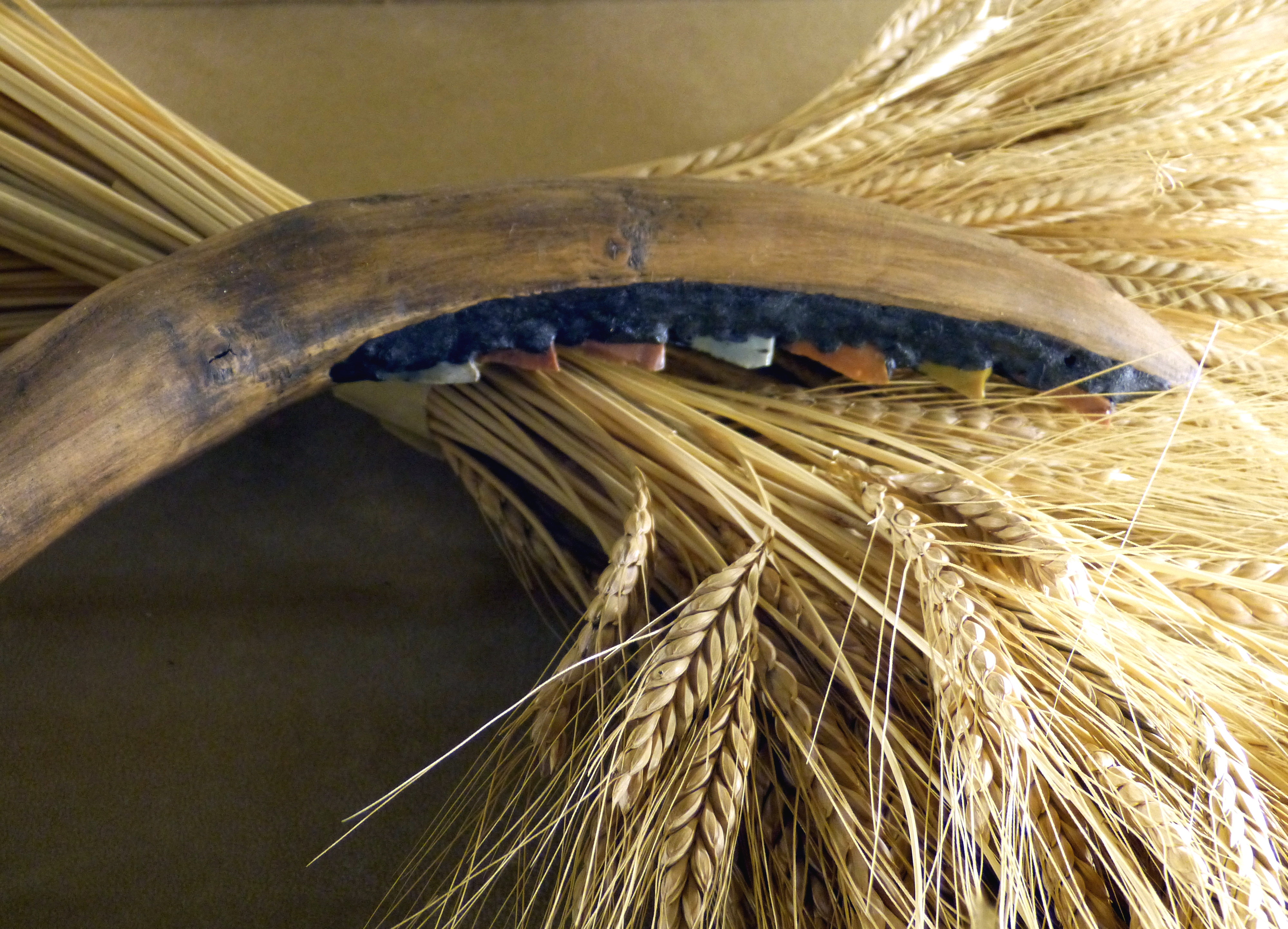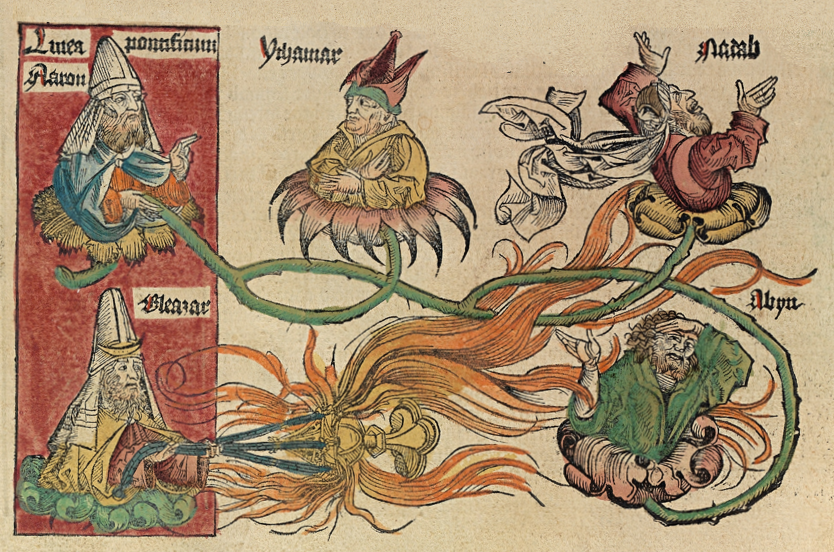|
Dough Offering
In Judaism, the dough offering (or separation of ''challah'', ) is an positive commandment requiring the owner of bread dough to give a part of the kneaded dough to a kohen (Jewish priest). The obligation to separate the dough offering (henceforth: challah) from the dough begins the moment the dough is kneaded, but may also be separated after the loaves are baked. This commandment is one of the twenty-four priestly gifts. By biblical law the commandment is only obligatory in the Land of Israel, but rabbinic law applies it also to bread made outside the Land of Israel. The common modern practice in Orthodox Judaism is to burn (although simply throwing away the dough in a double-wrapped container is allowed) the portion to be given the Kohen, although giving the ''challah'' to a Kohen for consumption is permitted—even encouraged—outside Israel (permitted with restrictions, see article below for detail). Hebrew Bible The offering is commanded in : In the above passage "cake ... [...More Info...] [...Related Items...] OR: [Wikipedia] [Google] [Baidu] |
Mishnah
The Mishnah or the Mishna (; , from the verb ''šānā'', "to study and review", also "secondary") is the first written collection of the Jewish oral traditions that are known as the Oral Torah. Having been collected in the 3rd century CE, it is the first work of rabbinic literature, written primarily in Mishnaic Hebrew but also partly in Jewish Palestinian Aramaic. The oldest surviving physical fragments of it are from the 6th to 7th centuries. The Mishnah was literary redaction, redacted by Judah ha-Nasi probably in Beit She'arim (Roman-era Jewish village), Beit Shearim or Sepphoris between the ending of the second century CE and the beginning of the third century. Heinrich Graetz, dissenting, places the Mishnah's compilation in 189 CE (see: H. Graetz, ''History of the Jews'', vol. 6, Philadelphia 1898, p105), and which date follows that penned by Rabbi Abraham ben David in his "Sefer HaKabbalah le-Ravad", or what was then ''anno'' 500 of the Seleucid era. in a time when the p ... [...More Info...] [...Related Items...] OR: [Wikipedia] [Google] [Baidu] |
Avena Sterilis
''Avena sterilis'' (animated oat, sterile oat, wild oat, wild red oat, winter wild oat; syn. ''Avena ludoviciana'' Durieu; ''Avena macrocarpa'' Moench; ''Avena sterilis'' ssp. ''sterilis''; ''Avena sterilis'' ssp. ''ludoviciana'') is a species of grass weed whose seeds are edible. Many common names of this plant refer to the movement of its panicle in the wind. Description Appearance ''Avena sterilis'' is a stout, broad-leaved grass that grows up to tall. At maturity, it has leaf blades that are up to long, and wide. It has an inflorescence that is either an equilateral or a slightly one-sided panicle. The spikelets usually have 3 florets, but can have anywhere from 2 to 5. The spikelets (without awns) are long; the glumes are long. The florets can either be a straw yellow or slightly reddish in colour. Occasionally, there can be reddish hairs at the base of the floret. The lemma is usually long. The florets are elongate and taper at the top. The two florets clo ... [...More Info...] [...Related Items...] OR: [Wikipedia] [Google] [Baidu] |
Hordeum Spontaneum
''Hordeum spontaneum'', commonly known as wild barley or spontaneous barley, is the wild form of the grass in the family Poaceae that gave rise to the cereal barley (''Hordeum vulgare''). Domestication is thought to have occurred on two occasions, first about ten thousand years ago in the Fertile Crescent and again later, several thousand kilometres further east. Description Wild barley is an annual grass and is very similar in form to cultivated barley (''Hordeum vulgare'') but has slightly narrower leaves, longer stems, longer awns, a brittle rachis, a longer, more slender seed spike and smaller grains. Characteristics of the wild plant that enhance its survival and dispersal include the brittle rachis (the central part of the seed head), which breaks when the grain is ripe, and the hulled seeds, which are arranged in two rows. In cultivated varieties, the rachis is more durable and the seeds are usually arranged in two or six rows. In the east, barley is usually grown for hum ... [...More Info...] [...Related Items...] OR: [Wikipedia] [Google] [Baidu] |
Triticum Spelta
Spelt (''Triticum spelta''), also known as dinkel wheat is a species of wheat. It is a relict crop, eaten in Central Europe and northern Spain. It is high in protein and may be considered a health food. Spelt was cultivated from the Neolithic period onward. It was a staple food in parts of Europe from the Bronze Age to the Middle Ages. It is used in baking, and is made into bread, pasta, and beer. It is sometimes considered a subspecies of the closely related common wheat (''T. aestivum''), in which case its botanical name is considered to be ''Triticum aestivum'' subsp. ''spelta''. It is a hexaploid, most likely a hybrid of wheat and emmer. Description Spelt is a species of ''Triticum'', a large stout grass similar to bread wheat. Its flowering spike is slenderer than that of bread wheat; when ripe, it bends somewhat from the vertical. The spike is roughly four-edged. The axis of the spike is brittle and divided into segments; it shatters into separate segments when ... [...More Info...] [...Related Items...] OR: [Wikipedia] [Google] [Baidu] |
Barley
Barley (), a member of the grass family, is a major cereal grain grown in temperate climates globally. It was one of the first cultivated grains; it was domesticated in the Fertile Crescent around 9000 BC, giving it nonshattering spikelets and making it much easier to harvest. Its use then spread throughout Eurasia by 2000 BC. Barley prefers relatively low temperatures and well-drained soil to grow. It is relatively tolerant of drought and soil salinity, but is less winter-hardy than wheat or rye. In 2023, barley was fourth among grains in quantity produced, 146 million tonnes, behind maize, rice, and wheat. Globally, 70% of barley production is used as animal feed, while 30% is used as a source of fermentable material for beer, or further distilled into whisky, and as a component of various foods. It is used in soups and stews and in barley bread of various cultures. Barley grains are commonly made into malt using a traditional and ancient method of preparatio ... [...More Info...] [...Related Items...] OR: [Wikipedia] [Google] [Baidu] |
Wheat
Wheat is a group of wild and crop domestication, domesticated Poaceae, grasses of the genus ''Triticum'' (). They are Agriculture, cultivated for their cereal grains, which are staple foods around the world. Well-known Taxonomy of wheat, wheat species and hybrids include the most widely grown common wheat (''T. aestivum''), spelt, durum, emmer, einkorn, and Khorasan wheat, Khorasan or Kamut. The archaeological record suggests that wheat was first cultivated in the regions of the Fertile Crescent around 9600 BC. Wheat is grown on a larger area of land than any other food crop ( in 2021). World trade in wheat is greater than that of all other crops combined. In 2021, world wheat production was , making it the second most-produced cereal after maize (known as corn in North America and Australia; wheat is often called corn in countries including Britain). Since 1960, world production of wheat and other grain crops has tripled and is expected to grow further through the middle of ... [...More Info...] [...Related Items...] OR: [Wikipedia] [Google] [Baidu] |
Five Species Of Grain
In Judaism, the five species of grain () refer to five varieties of grain which have special status for a number of rituals. These species are commonly considered to be wheat, barley, oats, rye and spelt. However, some of these identifications are disputed. Identity The five species, with their Mishnaic Hebrew names, are as follows: * ( ) – wheat * ( ) – spelt, but modernly taken to refer to emmer wheat * ( ) – barley * ( ) – oats or two-rowed barley. The name literally means "fox ear". Rashi holds this to be oats, and Maimonides holds it to be a type of "wild barley," while Rabbi Nathan ben Abraham called it by its Arabic name (Fox's spike). Zohar Amar and El'ad Kapah, ''The Yemenite Commentary of Rabbi Nathan, President of the Academy, on the Identification of Flora in the Mishnah'', pub. in: ''Mittuv Yosef – Yosef Tobi Jubilee Volume'', The Jews of Yemen: History and Culture (vol. 2), Haifa 2011, p. 13 (note 24) * ( ) ... [...More Info...] [...Related Items...] OR: [Wikipedia] [Google] [Baidu] |
Isaiah Di Trani
Isaiah di Trani ben Mali (the Elder) (c. 1180 – c. 1250) (), better known as the RID, was a prominent Italian Talmudist. Biography Isaiah originated in Trani, an ancient settlement of Jewish scholarship, and lived probably in Venice. He carried on a correspondence with Simhah of Speyer and with Simḥah's two pupils, Isaac ben Moses of Vienna and Abigdor Cohen of Vienna. Isaiah himself probably lived for some time in the Orient. He left a learned son, David, and a daughter, with whose son, Isaiah ben Elijah di Trani, he has often been confounded. Works Isaiah was a very prolific writer. He wrote: ''Nimmukim'' or ''Nimmukei Homesh,'' a commentary on the Pentateuch, consisting mainly of glosses on Rashi which show him to have been, as Güdemann says, an acute critic rather than a dispassionate exegete. The work has been printed as an appendix to Azulai's ''Penei Dawid'' (Leghorn, 1792); extracts from it have been published in Stern's edition of the Pentateuch (Vie ... [...More Info...] [...Related Items...] OR: [Wikipedia] [Google] [Baidu] |
Nachmanides
Moses ben Nachman ( ''Mōše ben-Nāḥmān'', "Moses son of Nachman"; 1194–1270), commonly known as Nachmanides (; ''Nakhmanídēs''), and also referred to by the acronym Ramban (; ) and by the contemporary nickname Bonastruc ça Porta (; literally "Mazel tov, Mazel Tov near the Gate", see ), was a leading medieval Jewish scholar, Jews of Catalonia, Catalan rabbi, philosophy, philosopher, physician, Kabbalah, kabbalist, and Jewish commentaries on the Bible, biblical commentator. He was raised, studied, and lived for most of his life in Girona, Catalonia. He is also considered to be an important figure in the re-establishment of the Jewish community in Jerusalem following its Siege of Jerusalem (1099), destruction by the Crusaders in 1099. Name "Nachmanides" () is a Greek language, Greek-influenced formation meaning "son of Nahman". He is also commonly known by the Hebrew acronym (Ra-M-Ba-N, for ''Rabbeinu Mōšeh bēn-Nāḥmān'', "Our Rabbi Moses son of Nahman"). His Cata ... [...More Info...] [...Related Items...] OR: [Wikipedia] [Google] [Baidu] |
Tevel
Tevel is a village in Tolna County, Hungary Hungary is a landlocked country in Central Europe. Spanning much of the Pannonian Basin, Carpathian Basin, it is bordered by Slovakia to the north, Ukraine to the northeast, Romania to the east and southeast, Serbia to the south, Croatia and .... External links Street map Populated places in Tolna County {{Tolna-geo-stub ... [...More Info...] [...Related Items...] OR: [Wikipedia] [Google] [Baidu] |
Kohen
Kohen (, ; , ، Arabic كاهن , Kahen) is the Hebrew word for "priest", used in reference to the Aaronic Priest#Judaism, priesthood, also called Aaronites or Aaronides. They are traditionally believed, and halakha, halakhically required, to be of direct Patrilineality, patrilineal descent from the biblical Aaron (also ''Aharon''), brother of Moses, and thus belong to the Tribe of Levi. During the existence of the Temple in Jerusalem (and previously the Tabernacle), ''kohanim'' performed the Temple korban, sacrificial offerings, which were only permitted to be offered by them. Following Siege of Jerusalem (70 CE), its destruction, it seems that most of them joined the Synagogal Judaism, Synagogal Jewish movement before adopting gradually Rabbinic Judaism, other types of Judaism, List of converts to Christianity from Judaism, Christianity or List of converts to Islam from Judaism, Islam. Today, ''kohanim'' retain a lesser though distinct status within Rabbinic Judaism, Rabbinic ... [...More Info...] [...Related Items...] OR: [Wikipedia] [Google] [Baidu] |




